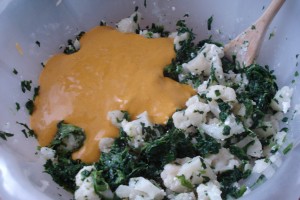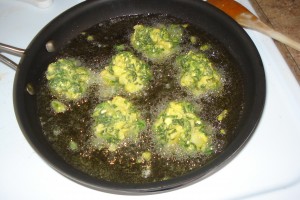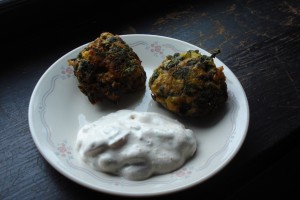After a recent visit to Abay, where I had the good luck to arrive on a day (for the second time) when chicken with peanut butter sauce was on their specials list, I found myself bit by the bug to attempt cooking some Ethiopian cuisine. My previous attempts to educate myself in Ethiopian cookery failed by virtue of the poor Ethiopian cookbook selection within the wider Carnegie Library borrowing system, and so I took to the internet in search of recipes. Chicken with peanut butter sauce was at the top of my list.
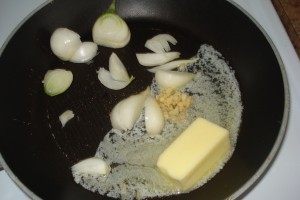 Ethiopian cuisine was fresh on my mind when Sabrina and I went to Tamarind’s Greentree buffet (keep your eyes peeled for a future blog on that experience) for lunch. Sabrina has already attempted delving into Ethiopian, but the persistent difficulty she reported was in creating a good berbere. For those who may not know, berbere is an Ethiopian spice mix, occupying a place in its cookery not unlike garam masala does in Indian cookery. That is to say, it is persistently mysterious, as seemingly everyone and every region does it differently, and yet it is ubiquitous as practically every recipe calls for it. Sabrina reported special difficulty making her own berbere because most of the recipes she found called for an inordinate proportion of paprika over other spices. Now, I’m a firm believer in the ethic that everything tastes better with paprika, but I believed Sabrina when she said that these recipes called for so much, that even such a mild, sweet spice overpowered most other flavors in the berbere. All in all, she found that her attempt to cook Ethiopian turned out edible, but no where near the flavors she had come to expect from Abay.
Ethiopian cuisine was fresh on my mind when Sabrina and I went to Tamarind’s Greentree buffet (keep your eyes peeled for a future blog on that experience) for lunch. Sabrina has already attempted delving into Ethiopian, but the persistent difficulty she reported was in creating a good berbere. For those who may not know, berbere is an Ethiopian spice mix, occupying a place in its cookery not unlike garam masala does in Indian cookery. That is to say, it is persistently mysterious, as seemingly everyone and every region does it differently, and yet it is ubiquitous as practically every recipe calls for it. Sabrina reported special difficulty making her own berbere because most of the recipes she found called for an inordinate proportion of paprika over other spices. Now, I’m a firm believer in the ethic that everything tastes better with paprika, but I believed Sabrina when she said that these recipes called for so much, that even such a mild, sweet spice overpowered most other flavors in the berbere. All in all, she found that her attempt to cook Ethiopian turned out edible, but no where near the flavors she had come to expect from Abay.
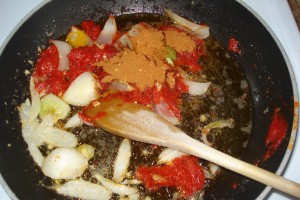 In the past, I have often made and enjoyed African peanut soup, which calls for no spices at all, let alone berbere, so I had confidence that I could find and make a peanut curry that would be tasty, whether or not it stood a chance against Abay’s chicken in peanut butter sauce. In my search, I found, as expected, many different variations on berbere, from spice mixes that were simple and straightforward, to mixes comprised of a laundry list of ingredients. After combing through a number of recipes for peanut chicken and berbere, I finally found one that looked intriguing and came with a relatively simple berbere recipe. Simple was definitely a selling point here, as I was looking more for a recipe that wouldn’t scare my parents (I mentioned in some recent recipe postings that I have been attempting to introduce my parents to recipes containing ginger, as it is purportedly of specific health benefit to my mother) than I was for a recipe that could stand up to Abay (two goals that might be mutually exclusive). Heeding Sabrina’s warning, I adjusted the proportions of the spice mix to be lighter on the paprika and heavier on the other spices than I originally found it.
In the past, I have often made and enjoyed African peanut soup, which calls for no spices at all, let alone berbere, so I had confidence that I could find and make a peanut curry that would be tasty, whether or not it stood a chance against Abay’s chicken in peanut butter sauce. In my search, I found, as expected, many different variations on berbere, from spice mixes that were simple and straightforward, to mixes comprised of a laundry list of ingredients. After combing through a number of recipes for peanut chicken and berbere, I finally found one that looked intriguing and came with a relatively simple berbere recipe. Simple was definitely a selling point here, as I was looking more for a recipe that wouldn’t scare my parents (I mentioned in some recent recipe postings that I have been attempting to introduce my parents to recipes containing ginger, as it is purportedly of specific health benefit to my mother) than I was for a recipe that could stand up to Abay (two goals that might be mutually exclusive). Heeding Sabrina’s warning, I adjusted the proportions of the spice mix to be lighter on the paprika and heavier on the other spices than I originally found it.
SIMPLE BERBERE
2 tablespoons paprika (or hot red pepper)
1 tablespoon ground ginger
1 teaspoon cinnamon
1/2 teaspoon ground cloves
Toss all spices together in a plastic bag or sealed container. Store with your spices, enjoy in your recipes.
I mixed this simple berbere at home and took it over to my parents’ house to tackle the rest of the recipe.
3 tablespoons butter
1 teaspoon minced garlic
2 onions, chopped
1 tablespoon ground ginger
1 tablespoon berbere
1/2 teaspoon black pepper
1 lb chicken pieces, tofu, vegetables, etc.
1/2 cup chicken stock
3 oz. tomato paste
1/3-1/2 cup peanut butter
3-4 hard boiled eggs
extra water
Hard-boil the eggs and set aside.
Melt butter in a medium saucepan or large skillet. Saute the onions, garlic and ginger for a few minutes until onions are softened. Add berbere and pepper and cook at least five minutes longer, adding a splash of water if the ingredients in the pan get too dry. If using chicken or other meat, then add the chicken pieces, the stock and enough water (or additional stock) so that the meat is submerged. Extra liquid may be necessary for stewing, and because this recipe contains ground nuts, it will thicken up easily later on. Still don’t go crazy; we just need enough to stew the meat. Tomato paste can also be added at this stage. Cover and simmer long enough for the meat to reach desired doneness. Follow the same procedure if using fresh vegetables, but go easy on the extra liquid.
Add the peanut butter, and stir in until combined. Heat through; sometimes it takes a little heat for the peanut butter to get thoroughly stirred in. Add extra water if the sauce gets too thick. Cut the eggs into halves or quarters. Pour the curry into your serving dish and arrange the eggs on top. Serve with rice or flatbread or all on its own.
This recipe does not taste like Abay’s chicken with peanut butter sauce, but it was quite tasty in its own right, and was enjoyed by all three of us. I especially liked the use of hard-boiled eggs as a curry ingredient, as I’m frequently looking for low-cost, low-carb items on which to enjoy curry sauce (and meat unfortunately doesn’t fall into low-cost). I enjoyed this recipe so much that I made it again for myself the next day, this time using chopped cabbage instead of chicken, a combination that also turned out swimmingly. I also attempted a recipe for Mesir Wat, Ethopian lentils in a more complex berbere sauce, but the consequences of that recipe will have to be a topic for another day.


